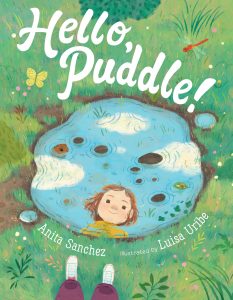 Winter is a desert. Even in a landscape with plenty of water, freezing temperatures turn the water to stone. The pond has a lid of ice, the bird bath is frozen solid. What’s a thirsty animal to do?
Winter is a desert. Even in a landscape with plenty of water, freezing temperatures turn the water to stone. The pond has a lid of ice, the bird bath is frozen solid. What’s a thirsty animal to do?
It’s possible, of course, to eat snow, but like eating ice cream, eating snow or nibbling icicles really lowers the body temperature. That’s nice on a summer’s day, but to an animal struggling to survive in winter, even a slight lowering of body temperature could have bad results.
What happens to a mud puddle in winter? Well, a puddle is just water, right? and water freezes. So a winter puddle is just some frozen muddy water.
Except, as you know if you’ve ever stepped in a puddle in the winter time, it isn’t always frozen. As you stand there with icy water seeping through your socks, you realize that under a thin skim of ice on the surface, a puddle can be wet even in subfreezing temperatures.
But how can this be? If the air temperature is below 32, shouldn’t the puddle be frozen?
Well, what is a puddle? It’s water filling up a hollow in the earth. And it turns out that soil is really, really good insulation. I remember reading about sod houses on the prairie—they may have been damp and muddy, but they were delightfully cool in summer and cozily warm in winter. The earth gets warmer the farther down you go. Even in the bitterest winter, only the upper skin of soil freezes hard—just a few inches down, worms wriggle and moles tunnel, and tree roots suck up water.
So the puddle is essentially sitting on top of a source of heat. And while the shallowest puddles will freeze eventually, deeper ones may continue to be unfrozen for long into the winter. Especially if it’s a place where there’s the slightest motion of the water seeping up in a low, damp spot in the grass.
A winter puddle is a gift for squirrels, deer, wild turkeys, songbirds, and so many other animals, trying like us to make it through till spring comes.
 To find out more about puddles and the amazing variety of wildlife that depend on this odd, ignored habitat, please check out my picture book: Hello, Puddle!
To find out more about puddles and the amazing variety of wildlife that depend on this odd, ignored habitat, please check out my picture book: Hello, Puddle!





We’ve got ditches lining all the streets in my neighborhood because there is so much runoff from hillsides when it rains. It’s a bounty for the birds and other animals that live in our boundary-land between suburbs and countryside: subfreezing temperatures and snow kept us all locked up recently for a week and a half, but the water ran through the ditches without stop, trickling with lovely stream noises, and the paths of pawprints and hoofprints and little bird scratchings showed that many creatures were using it as a water source.
That’s lovely. Ditches are highly under-rated habitats!